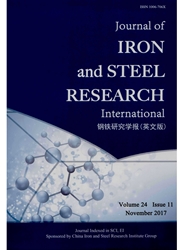

 中文摘要:
中文摘要:
29 种(24 个类, 6 个家庭) 在东北典型、普通的蝴蝶,中国被选择借助于扫描电子显微镜学和接触角测量系统在模式, hydrophobicity 和 hydrophobicity 机制上做质、量的研究。规模表面由 submicro 班组成垂直凸圆和水平连接。规模的距离是 48—91 渭 m,长度 65—150 渭 m,和宽度 35—70 渭 m。submicro 班的 Thedistance 规模上的垂直凸圆是 1.06—2.74 渭 m,高度 200—900 nm,和宽度 200—840 nm。蝴蝶翅膀的表面上的更好的 hydrophobicity (静态的接触 angle136.3 掳—156.6 °) 被贡献微班的规模和 submicro 班的合作效果翅膀上的垂直凸圆出现。Cassie 方程被修订,并且新数学模型和方程被建立。
 英文摘要:
英文摘要:
Twenty-nine species (24 genera, 6 families) of butterflies typical and common in northeast China were selected to make qualitative and quantitative studies on the pattern, hydrophobicity and hydrophobicity mechanism by means of scanning electron microscopy and contact angle measuring system. The scale surface is composed of submicro-class vertical gibbosities and horizontal links. The distance of scale is 48-91μm, length 65-150μm, and width 35-70μm. The distance of submicro-class vertical gibbosities on scale is 1.05-2.74μm, height 200-900 nm, and width 200-40 nm. The better hydropho- bicity on the surface of butterfly wing (static contact angle 136.3°-156.6°) is contributed to the co-effects of micro-class scale and submicro-class vertical gibbosities on the wing surface. The Cassie equation was revised, and new mathematical models and equations were established.
 同期刊论文项目
同期刊论文项目
 同项目期刊论文
同项目期刊论文
 Biomimetic Construction of Category Mental Imagery Based on Recognition Mechanism of Visual Cortex o
Biomimetic Construction of Category Mental Imagery Based on Recognition Mechanism of Visual Cortex o Study on preheating and annealing treatments to biomimetic non-smooth cast iron sample with high the
Study on preheating and annealing treatments to biomimetic non-smooth cast iron sample with high the Optimization of Laser Processing Parameters and Their Effecton Penetration Depth and Surface Roughne
Optimization of Laser Processing Parameters and Their Effecton Penetration Depth and Surface Roughne Macro-/Micro-Structures of elytra, mechanical properties of the biomaterial and the coupling strengt
Macro-/Micro-Structures of elytra, mechanical properties of the biomaterial and the coupling strengt Friction and wear property of duplex MAO/CrN coatings sliding against Si3N4 ceramic balls in air, wa
Friction and wear property of duplex MAO/CrN coatings sliding against Si3N4 ceramic balls in air, wa Study on adhesion resistance behavior of sample with striated non-smooth surface by laser processing
Study on adhesion resistance behavior of sample with striated non-smooth surface by laser processing Contact mechanics of pad of grasshopper (Insecta: ORTHOPTERA) by finite element methods. Chinese Sci
Contact mechanics of pad of grasshopper (Insecta: ORTHOPTERA) by finite element methods. Chinese Sci Biomimetic coupling effect of non-smooth mechanical property and microstructural features on thermal
Biomimetic coupling effect of non-smooth mechanical property and microstructural features on thermal Effects of graphite shape on thermal fatigue resistance of cast iron with biomimetic non-smooth surf
Effects of graphite shape on thermal fatigue resistance of cast iron with biomimetic non-smooth surf Effect of medium on friction and wear properties of compacted graphite cast iron processed by biomim
Effect of medium on friction and wear properties of compacted graphite cast iron processed by biomim Effects of pre-placed coating thickness on thermal fatigue resistance of cast iron with biomimetic n
Effects of pre-placed coating thickness on thermal fatigue resistance of cast iron with biomimetic n Biological coupling anti-wear properties of three typical molluscan shells—scapharca subcrenata, rap
Biological coupling anti-wear properties of three typical molluscan shells—scapharca subcrenata, rap 期刊信息
期刊信息
